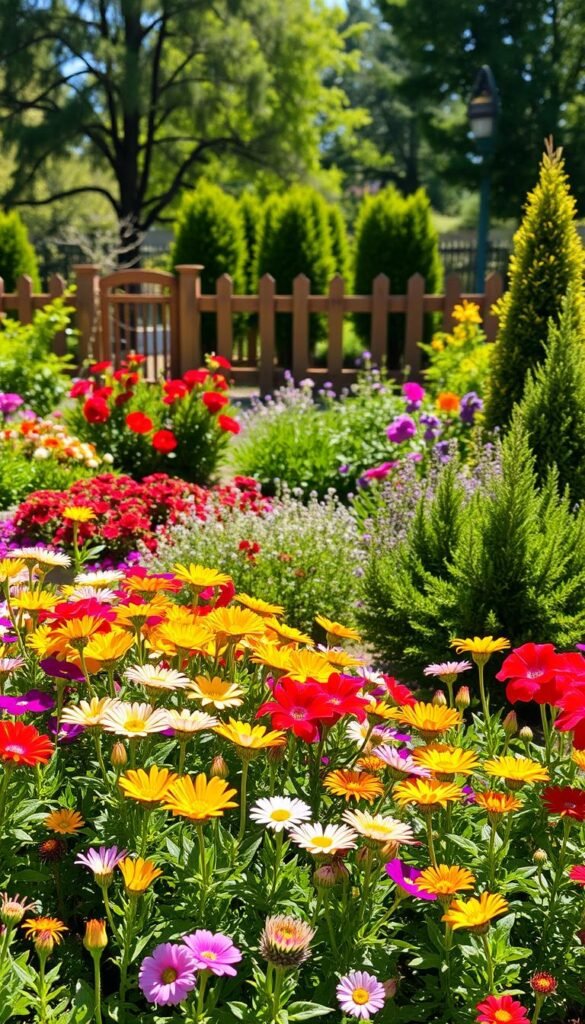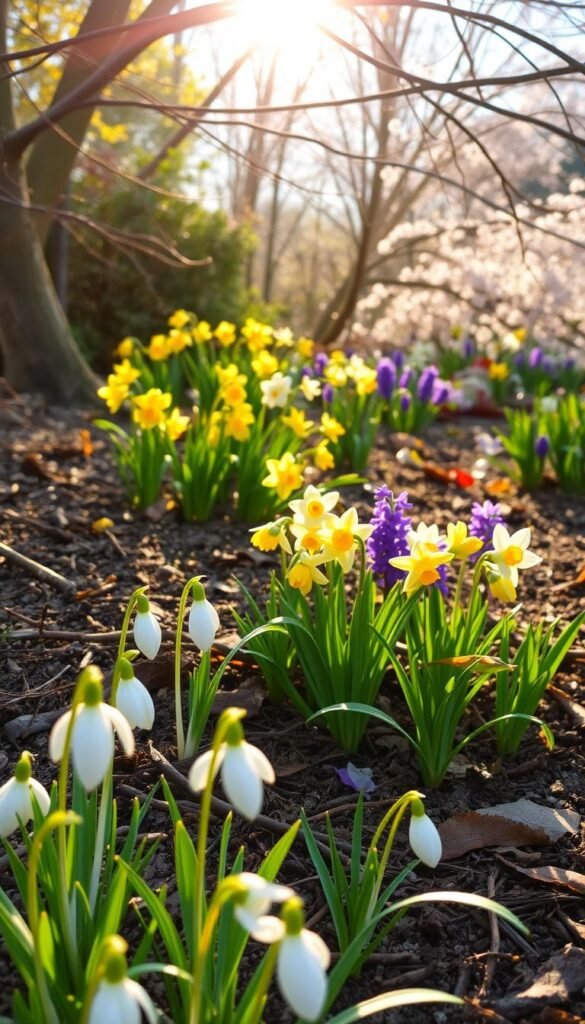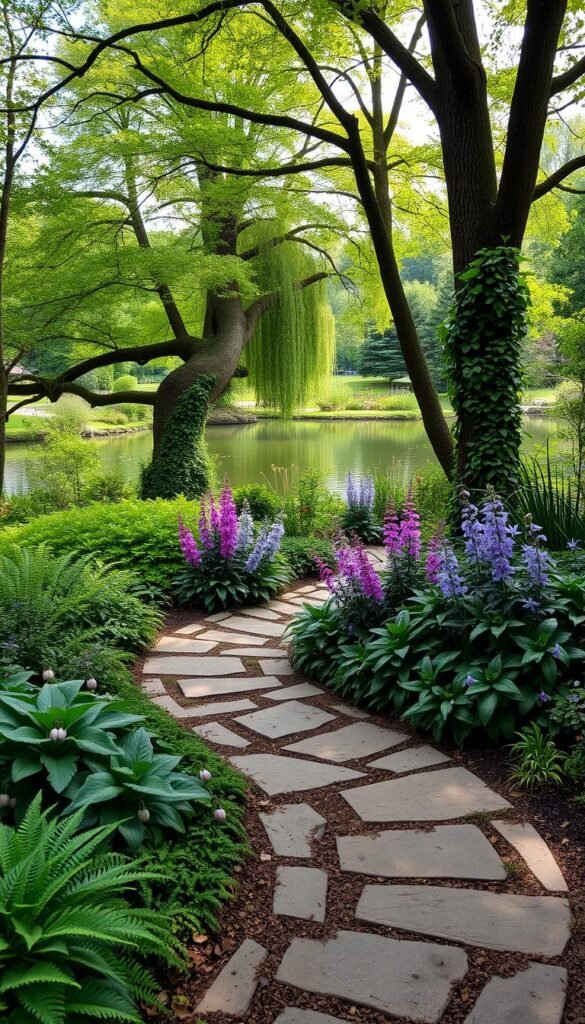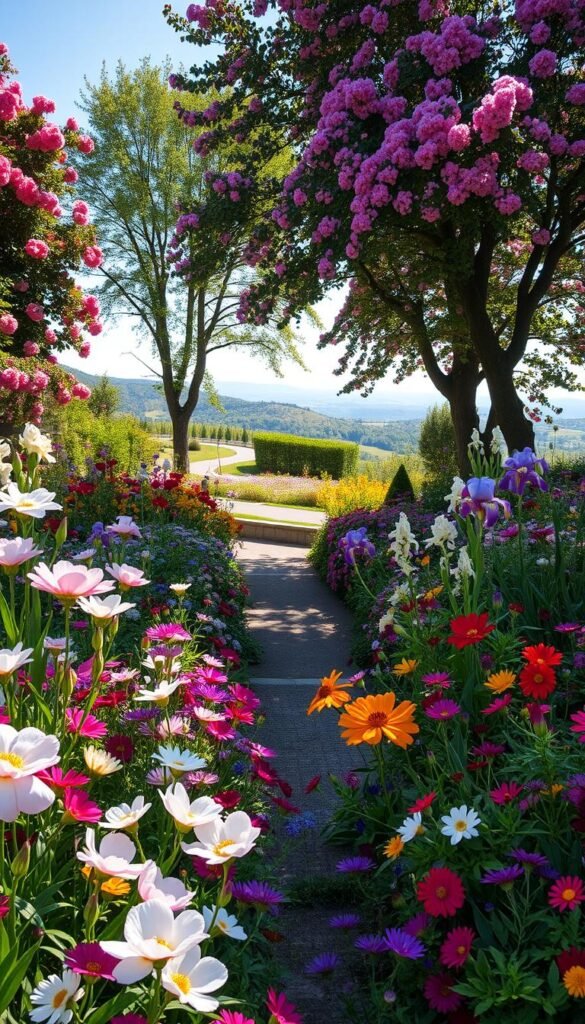Imagine stepping outside to a vibrant mix of colors that shifts gracefully with the seasons. Crafting a space that thrives every month isn’t just about luck—it’s about smart planning and knowing which plants complement each other. This guide will show you how to design a living tapestry that evolves from spring’s first buds to winter’s frost-resistant highlights.
By blending early bloomers, summer stars, and autumn showstoppers, you’ll create visual harmony that lasts. Think about texture and height: tall spires of delphiniums behind creeping phlox add depth, while drought-tolerant varieties like coneflowers keep maintenance simple. Pair warm-toned marigolds with cool lavender spikes for dynamic contrast.
Don’t forget structure! Evergreen shrubs or ornamental grasses anchor your design during quieter months. For effortless beauty, consider low-maintenance flowers in raised beds, which offer better drainage and easier access. With thoughtful choices, your plot becomes a sanctuary that delights you—and local pollinators—365 days a year.
Transform Your Outdoor Space with Seasonal Blooms

Think of your plot as a stage for ever-changing botanical acts. To keep the show running all year, you’ll need a mix of performers that shine in different seasons. Start by sketching your area’s sun patterns—some spots bake in summer but stay shaded in spring.
Planning for Year-Round Color in Your Garden
Staggered blooming periods are your secret weapon. Pair early risers like crocuses with late stars such as asters. This tag-team approach ensures something’s always popping while others rest.
Create a simple calendar tracking peak displays. February might feature hellebores, while July highlights daylilies. Spot gaps? Fill them with quick-growers like zinnias. Layer heights too—tall foxgloves behind mounding geraniums add drama.
Don’t forget texture! Feathery cosmos contrast beautifully with bold dahlias. For low-fuss options, try self-seeding varieties that return yearly. Your space becomes a living mosaic that evolves with nature’s clock.
Understanding Your Garden’s Climate and Soil

Your garden’s success starts beneath the surface. Healthy growth begins with soil that breathes—think of it as a living ecosystem. Before planting, grab a handful and squeeze. Does it crumble like chocolate cake or clump like wet clay? This simple test reveals texture and drainage needs.
Tailoring Soil and Sunlight for Peak Growth
Turn over the top 4-6 inches of earth to break up compacted areas. This lets roots stretch while clearing weeds. Mix in compost or aged manure—nature’s multivitamin for plants. As one gardener puts it: “Feed the soil, and the soil feeds your blooms.”
Sunlight patterns shift through seasons. Track how shadows fall in spring versus summer. Full-sun lovers like marigolds need six hours of direct light, while colorful container gardening options thrive in movable pots for changing conditions.
Test your soil’s pH using a $10 kit from any garden store. Most flowers prefer slightly acidic soil (6.0-7.0). Adjust with lime to raise pH or sulfur to lower it. Remember: matching plants to your unique ground conditions beats fighting nature every time.
Selecting Flowers for Every Season

Timing is everything when curating a space that transitions smoothly between seasons. By pairing cold-hardy champions with spring’s bold performers, you’ll craft a landscape that never sleeps. Let’s explore nature’s calendar stars that shine when others rest.
Winter Wonders: Snowdrops, Witch Hazel, and More
Snowdrops defy frosty conditions, often blooming through lingering snow. Plant their bulbs in fall for delicate white flowers that signal winter’s end. Pair them with witch hazel shrubs, whose spidery yellow or orange blossoms perfume the air as early as January.
These hardy choices create focal points when most plants remain dormant. As one horticulturist notes: “Late winter bloomers are nature’s promise that warmth will return.”
Spring Spectacles: Tulips, Daffodils, and Iris
Nothing shouts “spring” like tulips’ candy-colored cups. Plant bulbs in autumn for a rainbow display—they thrive in most soils with minimal care. Daffodils follow close behind, their sunny faces feeding early pollinators while multiplying yearly.
For late spring drama, add bearded iris. Their sword-like leaves frame blooms in jewel tones, perfect for vibrant displays that bridge seasons. They demand full sun but reward you with staggered flowering.
| Plant | Bloom Time | Key Features | Care Tip |
|---|---|---|---|
| Snowdrops | Late winter – early spring | Frost-resistant white blooms | Plant bulbs 3″ deep in fall |
| Witch Hazel | Late winter | Fragrant ribbon-like flowers | Prune after flowering |
| Tulips | Early spring | Vibrant cup-shaped blooms | Remove spent flowers |
| Daffodils | Early spring | Naturalizing yellow varieties | Leave foliage until yellow |
Creating a Native Flower Bed

What if your garden could thrive with minimal effort while supporting local wildlife? Native plant beds answer this challenge beautifully. These living ecosystems work smarter, not harder, by tapping into nature’s existing blueprints.
Benefits of Local Plant Varieties
Native plants are survival experts in your region’s climate. They’ve spent centuries adapting to local rainfall, soil types, and temperature swings. This means less watering, no fancy fertilizers, and natural pest resistance.
Want butterflies dancing through your space? Plant cornflower—its nectar-rich blooms act like neon signs for pollinators. Hummingbirds flock to salvia’s tubular flowers, which evolved perfectly for their long beaks. As one ecologist notes: “Local flora and fauna speak the same language—they just need an introduction.”
Here’s why these beds shine:
- Cut water use by 50% compared to non-native species
- Provide year-round food sources for bees and birds
- Reseed naturally, filling gaps without your help
Start by researching plants native to your USDA zone. Purple coneflower thrives in Midwest prairies, while California poppies blaze across western slopes. Your plot becomes a living postcard of your region’s natural beauty—no green thumb required.
Outdoor Flower Garden Ideas: Seasonal Blooms for a Year-Round Display
Crafting a garden that dazzles in every season feels like conducting nature’s orchestra—each plant plays its part at the perfect moment. Start by mapping bloom cycles on paper, noting when peonies bow out and black-eyed Susans take center stage. This ensures your space stays lively even as temperatures shift.
Pair early risers like bleeding hearts with latecomers like sedum. Their staggered performances create seamless transitions. For example, spring tulips can share beds with summer phlox, which then hand off to autumn asters. “The magic happens when you think in layers,” says a landscape designer.
Color harmony matters too. Cool-toned salvias blend beautifully with warm marigolds, while spiky lupines contrast round hydrangea blooms. Here’s a quick guide to keep the show running:
| Bloom Period | Early Stars | Mid-Season Players | Late Showstoppers |
|---|---|---|---|
| Spring | Crocus | Peony | Allium |
| Summer | Coreopsis | Daylily | Russian Sage |
| Fall | Goldenrod | Mums | Sedum |
Your choices should mirror your personality. Prefer cottage charm? Mix foxgloves and daisies. Love modern lines? Try ornamental grasses paired with dahlias. For creative ways to decorate your space, blend textures and heights to craft visual rhythm.
Remember, timing is everything. Plant bulbs in fall for spring pops, and sow annuals as frost risks fade. With smart planning, your garden becomes a living calendar that surprises you month after month.
Designing Your Garden Layout for Light and Shade

Light shapes your space’s personality more than you might realize. Start by tracking how sunlight dances across your yard throughout the day. Morning rays differ from harsh afternoon beams—some spots bake while others stay cool. This knowledge becomes your blueprint for plant placement.
Maximizing Full Sun Exposure versus Partial Shade
Sun worshippers like lavender and coneflowers crave six hours of direct light. Position them where shadows rarely fall. Meanwhile, areas with dappled afternoon shade suit coleus or coral bells perfectly. As one landscaper advises: “Watch your yard like a sundial for three days—you’ll spot patterns you never noticed.”
Morning sun with afternoon protection? That’s prime real estate for hydrangeas and ferns. These partial shade champions thrive when shielded from midday intensity. Got a dim corner? Transform it with impatiens’ bright pops or begonias’ waxy leaves—they’ll turn forgotten spaces into lush retreats.
Remember: your layout should celebrate natural light quirks, not fight them. Pair each plant’s needs with your yard’s unique rhythm. When blooms align with their preferred conditions, they reward you with vigorous growth and vibrant shows.
Incorporating Ground Covers and Low-Growing Varieties
Layers are the secret weapon for gardens that look full from every angle. Start by arranging taller plants at the back of beds, mid-height varieties in the center, and ground cover hugging the front edges. This tiered approach creates depth while letting each plant shine.
The Role of Ground Cover in Achieving a Lush Look
These low-growing heroes do more than fill space. They lock moisture in the soil, block weeds naturally, and soften edges between pathways and beds. Winter heath proves this point beautifully—its evergreen leaves and pink blossoms add life when other plants sleep.
Sedum varieties thrive where others struggle. Their fleshy leaves store water, making them perfect for sunny slopes. Come summer, they burst into tiny star-shaped flowers that butterflies adore. For early color, try creeping phlox. Its carpet of blooms appears as frost fades, creating seamless transitions between seasons.
One landscaper shares: “Ground cover acts like nature’s glue—it holds your design together while doing the heavy lifting.” Pair these workhorses with taller plants, and you’ll craft spaces that feel intentional yet effortless.
Choosing Perennials, Annuals, and Bulbs for Continuous Bloom
The secret to nonstop color lies in mixing plant types that work together like clockwork. Perennials like peonies form your garden’s backbone, returning yearly with lush blooms that make stunning bouquets. These hardy plants can thrive for decades—some varieties outlive their gardeners!
Pair them with annuals that deliver instant impact. Black-eyed Susans dazzle from summer through frost, their golden petals glowing as temperatures drop. For layered texture, add hydrangeas—their mophead flowers shift hues from late spring to fall, creating living mood rings.
Don’t overlook bulbs! Tulips and daffodils pop up early, then make room for summer stars. Roses fit beautifully too, though they’ll need specific sun and soil. “Match varieties to your conditions,” advises a master gardener. “Hybrid teas love attention, while shrub roses handle neglect.”
By blending these categories, you craft a self-renewing display. Sturdy perennials anchor beds while annuals fill gaps with fresh energy. The result? A dynamic space where something’s always waking up, peaking, or resting—nature’s perfect relay race.






